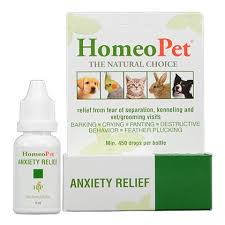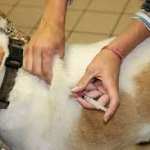It often seems like the world is divided into 2 camps. Those who “get” anxious and reactive dogs, and those that don’t. Those that don’t can be dismissive and unkind. Pet parents of these dogs have an incredible amount of patience, kindness, and selflessness it takes to live with and try to help these dogs. Many people do get them, but may not have the qualities it takes to live with and rehabilitate them. It turns out that I don’t actually have that level of patience and the proper household needed, in addition to the level of energy and time it takes to properly help these dogs. At least, not to knowingly adopt one of these emotionally “special needs” dogs. At least, not at this point in my life. I am admitting this, even though I am an animal lover, and veterinarian.
Yet, I have clients that do have the time, and seemingly unlimited patience to work with these dogs. In case you are reading this, moms of Bennett, Gabby, Monkey, Lucy, etc… this means you . You are all amazing, in that you work your lives around your dogs while most people would not spend the time and money working with such anxious dogs. But, I am more than glad to help work with you and them. You might be interested to know that completely calm, bombproof dogs are closer to the exception than the rule. Most dogs have something they are not good with, and thus are on another end of a spectrum of anxiety, and may just not yet be diagnosed. They may have real issues with alone time, storms, cats or children, or a combination thereof. Increased awareness has helped identify more and more of these dogs. And the good news, to those of you reading this and identifying with this conversation, is that there is hope. There are now many more, easier tactics to help anxious dogs that you may be able to avail yourself of. Here are some of them: specifically 8 ways to try to hopefully make life with your anxious or reactive dog better for both of you.
- Seek out a PR trainer.Recently, modern trainers have learned that an overwhelming majority of dogs who lunge at, bark at and fight with other dogs and humans aren’t doing so because they’re “dominant” or because they want to be “pack leader”. They are doing it because they are scared. A frightened dog, especially one who feels like she is trapped, will turn to aggression to “get him before he gets me”.
Once we determine that aggression is rooted in fear, we know to avoid trainers who “rehabilitate” aggressive dogs by dominating. Hurting a dog is unacceptable in all forms of training, and especially in this situation. It will not stop her from being scared, and will just shut her down. Change the emotion and you will change the behavior. Find a good trainer, and ideally one who follows positive reinforcement principles and is certified by CCPDT.
2. Make her visible. This might seem counterintuitive to what you would want to do with an anxious dog. Yet, drawing attention to your dog’s anxiety is a good way to tell other people not to approach. Consider some “marking” such as a bandana or harness that says “nervous” or “No dogs” and you’re giving people a heads-up without having to yell at them. You should be able to walk your dog, leashed, in public. Just be sure you can control your dog, and that she doesn’t lunge and overpower you. If so, these suggestions should be a nice compromise to keeping her indoors all day, or confined to your yard.
3. Muzzle up If your dog is reactive and big enough that you could lose control if she lunges, consider a good quality muzzle. Leather ones are the easiest to put on, and they can breathe and drink with them on easily. Remember thatgoogle calendar
muzzled dog is still seen by most people as a dangerous dogs, which may lead to some unpleasantness for the pet parent.
Check out the Muzzle Up! Project muzzleupproject.com. It is trying to get rid of that prejudice and spread the word that a muzzle is a sign of a responsible owner and a safe dog. By making those with aggressive dogs feel safer, muzzles allow both people and dogs to get more enjoyment from being outside.
4. Consider changing your vet if he/she isn’t tuned in to your dog’s needs. While some vets are great with nervous and aggressive dogs, others are still very old school, or new school and not well matched to your needs. They may not listen to owners and use invasive and rough handling. There are newer techniques out there for these situations. The late Dr. Sophia Yin developed a program for veterinarians that focuses on low-stress handling. It can make a huge difference in your dog’s anxiety levels (see: drsophiayin.com/low stress). And Dogs in Need of Space (dogsinneedofspace.com) has a list of veterinarians who go the extra mile for anxious dogs. I am a house call vet, and have a number of anxious patients that simply do better in their own home, with or without anti-anxiety medication or sedatives.
5. Learn your dog’s body language. Your dog is constantly communicating how he is feeling. The more well versed you are in his language, the better equipped you will be to understand what he is saying and feeling. Thus, it will be easier to avoid stressful situations. Something that was fine for him last week might be too much to cope with today, due to a phenomenon called “trigger stacking”. It is an increase in anxiety-related behaviors caused by the dog experiencing repeated stressful events without enough imd in between for the associated stress hormones to leave his system. Avoid this by keeping an eye out for signs that tell you how your dog is feeling.
There are lots of resources for leaning the basics. Lili Chin has made some great posters (find them at doggiedrawings.net; click on Education Graphics),. And there’s even an iPhone app to make things easier.

 6. Try medication. Depending on the level anxiety, there are levels of anti anxiety medication or supplements available to you. Anxiety caught early may be amenable to reversal with herbal supplements as needed, along with proper training. Yet, many dogs need antidepressants,, which are the same medications used by people, and have been proven to helped dogs as well. Your vet may medicate and work with you directly, or may refer you to a veterinary behaviorist. I often do this, because I practice in a territory near a few exceptional specialists. They may also liaise with your trainer or applied animal behaviorist. (See my old blog describing the differences.) Note: not all “calming supplements” available over the counter are all the same. Ask your vet.
6. Try medication. Depending on the level anxiety, there are levels of anti anxiety medication or supplements available to you. Anxiety caught early may be amenable to reversal with herbal supplements as needed, along with proper training. Yet, many dogs need antidepressants,, which are the same medications used by people, and have been proven to helped dogs as well. Your vet may medicate and work with you directly, or may refer you to a veterinary behaviorist. I often do this, because I practice in a territory near a few exceptional specialists. They may also liaise with your trainer or applied animal behaviorist. (See my old blog describing the differences.) Note: not all “calming supplements” available over the counter are all the same. Ask your vet.
7. Find a shared interest. It is okay to be disappointed that your dog doesn’t want to go to the dog park, agility trials or pavement cafes. Try focusing on what it is that you CAN do together instead. Go on jogs, or wilderness hikes, take nose-work classes, or just chill at home. Not forcing the dog to be what he is not will help you find the dog he is, and you will both be happier for it.
8. Know your limits. If you’re really out of your depth, or your dog represents a serious danger to you or your children or grandchildren, or is a legal liability, it is ok to consider rehoming. There may be the perfect environment for your dog waiting for him elsewhere. The cost of training and medication may be cost prohibitive, and may be required lifelong. Ultimately, a new home may be the best thing for your dog.
Hope this is helpful for you or someone you know.
Dr. Dawn
Please share and subscribe here







